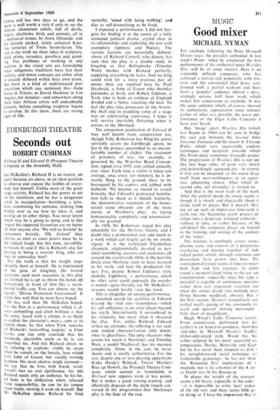MUSIC
Good mixer
MICHAEL NYMAN
For anybody following the Peter Maxwell Davies saga, the paradox embodied in last week's Prom—when he conducted the first performance of his orchestral piece Worldes Blis--will be of sonic interest. Here is an ostensibly difficult composer, who has achieved a certain cult popularity with fox- trots and the sensational Mad King. con- fronted with a partial walkout and boos from a 'popular' audience offered a deva- statingly serious half hour work which makes few concessions to anybody. It was the same audience which, of course, showed its enthusiastic appreciation sonic minutes earlier of what was possibly the worst per- formance of the Elgar Cello Concerto I have ever heard.
But, 'image' apart. Worldes Rlis (which was begun in 1966) can be seen to bridge the. vast gap between the Second John Taverner Fantasia and the recent Si Thomas Wake, which very successfully exploits techniques and materials towards which this Prom piece sometimes dol.:Redly gropes. The progression of Worldes Ms is not un- like two huge tubes of paint very slowly and painstakingly squeezed dry—in reverse if that can be imagined, as the music drag, itself from near-nothingness to an aggres sive. spluttering climax. After which th second tube, not dissimilar, is started on.
And that is the main fault of the work After the central spasm the music seems a• though it is slowly and elegiacally about te shake itself to pieces. But it doesn't. Hav ing set up such an impressive time-scale tc work out. the 'beginning again' process de velops into a desperate, tortured verbosity— verbose in spite, or rather because. of the self-denial the composer places on himself in the forming and mixing of the contents of the 'tubes'.
The mixture is startlingly severe, mono chrome even, and consists of a progressive overlaying and piecing together of indi. vidual points which, through extension and decoration, have grown into lines. Thi, contrapuntal texture seems at times to negatr both high and low registers, to centre round a no-man's-land tiring to the car ant concentration—especially since this type o' material is capable of continuous mutatiot. rather than real structured variation and when the strings divide into multiple part, things become needlessly obscure. But. i• the first section, Davies's scrupulously cor trolled snail's pacing of the constantly In ward and upward striving movement little short of magnificent.
Hugh Wood's Cello Concerto (anoth. Prom commission, performed two da, earlier) is an honest-to-goodness. short-bac And-sides to Maxwell Davies's bouffai elaborately-tiered style. Wood has bee rather eclipsed by his more successful co temporaries, Davies, Birtwistle and Goel- but he has never been tempted to dish s his straightforward serial technique -wl• fashionable gesturings: he has not shirk the 'Romantic Era' implications of t medium, nor is he ashamed of the A str; as Goehr was in his Ronzanza.
In places the weight of the convent seems a bit heavy, especially in the cader —it is impossible to write 'new' caden of the old sort, and there seems little pe in doing so. T have the impression that ti- were included as a joke, a foil to the 'shock' orchestral passages which succeeded them. Although the idiom was not unfamiliar the work progressed by a series of such shock tactics: the shortish sections skilfully articulated with a minimum of notes (praise be), but with a control of inner movement which even in such an overtly 'thematic' style is very rare. However, it is in the fact that Wood's serial processes are almost al- ways audible (he doesn't go in for Babbitt- type manipulations), that some of the trouble lies. Here, he seemed too dependent on the first three, rather obtrusive, notes of his series for my ear's comfort. But there seems no reason why this concerto should not become a regular part of the repertory—in itself unusual, for new works are rarely heard a second time—in which case recognisability is no bad thing.



































 Previous page
Previous page